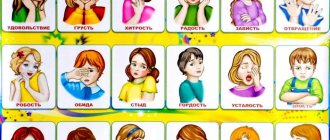One of the most interesting and mysterious areas of our psyche is the world of emotions. Studied for thousands of years by scientists from various fields of knowledge, it still keeps many of its secrets and mysteries. Emotions permeate our entire life, making it bright, rich, sometimes tremulous and tender, sometimes filled with unbearable burning pain. Yes, they are this life itself, because where feelings disappear, human existence ends.
It is psychology that most fully reveals the essence of this area of the human psyche - the only science that has managed to organically link together the physiological basis and manifestations of emotional states.
What are emotional states
In psychology, the concept of “emotions” is used both in a broad sense, as emotional states, and in a narrow sense, as one of the types of these states, along with feelings, moods, affects, etc. Emotional states are a special class of mental phenomena that reflect attitudes man to the world.
Emotions and needs
Interacting with the world around us and with other people, a person constantly encounters situations that evoke different attitudes in him: joy or indignation, sadness or hatred, surprise or sympathy. That is, a person reflects the world and stores information in memory not only in images and concepts, but also in the form of sensory experiences - emotions.
Emotions are closely related to human needs. Those life circumstances, situations or people that contribute to the satisfaction of needs cause us positive emotions, and those that interfere or hinder us cause negative emotions. It's so simple and complicated at the same time.
- Firstly, we are not always aware of our needs, but we always experience the emotions associated with them. Therefore, we often cannot even explain to ourselves why we don’t like this or that person, or why our mood suddenly deteriorated.
- Secondly, a person lives a complex and multifaceted life, and often his needs come into conflict not only with the needs of other people, but also with his own desires. Therefore, understanding this confusing and chaotic whirlpool of emotions can be extremely difficult even for an experienced psychologist. You probably know that you can love and hate the same person at the same time, or be afraid and look forward to some event at the same time.
You can deal with your experiences only by realizing and bringing your confused desires and needs into at least relative order. Experienced psychotherapists can help a person with this. After all, only by understanding and accepting your needs or consciously abandoning them can you reduce the severity of negative experiences.
Psychophysiology of emotional states
Emotions are the oldest type of mental states; animals have them and are associated with the satisfaction of natural, and in higher animals, social needs.
- The antiquity of this type of mental state is confirmed by the fact that they are born in the old, from an evolutionary point of view, subcortical part of the brain - in the limbic system. By the way, the name is very telling. Limbo is purgatory, a place between heaven and hell, and even deeper lurks animal instincts and hidden, often dark desires and needs. They sometimes break through from the subconscious level, awakening in us strange emotions that frighten even ourselves.
- But the expression of emotions is controlled and controlled by the “youngest” and most rational part of the brain – the neocortex (“new cortex”). And when the rational part of the brain turns off, for example, during severe alcohol intoxication or in a state of passion, then emotions go out of our control, and behavior begins to be controlled by instincts, not reason.
Any external influence causes a focus of excitation in the cerebral cortex. If the irritation is weak, then the focus quickly fades, but the stronger the impact, the larger and more stable this focus is. Penetrating into the subcortical zone, it activates the centers of emotions.
Emotions, in turn, cause various changes in the physiological systems of the body, because emotions are a signal about the nature of the impact of the stimulus. And if they are negative, then our body is rebuilt, preparing to repel danger or run away from it. Moreover, for our brain, it turns out, it doesn’t matter whether the enemy is real or imaginary - the signal to restructure the body’s functioning is still received, and we experience various, often unpleasant, sensations. Thus, the emergence of a feeling of fear is accompanied by the following processes:
- Adrenaline is released into the blood, which should increase the supply of oxygen to the muscles and activate the sympathetic nervous system;
- blood and nutritional resources are directed to support the muscular system; this reduces the supply to other body systems, so a person feels cold, chills, his face turns pale, and due to lack of blood supply, dizziness and even loss of consciousness may occur;
- in order to cope with the increased needs for blood supply, the heart begins to beat faster, breathing quickens to supply the blood with oxygen and, as a result, difficulties arise with speech;
- rational control over behavior decreases, since the functions of the cerebral cortex are somewhat suppressed, and the person literally becomes stupid and does not think rationally well.
Changes in the functioning of various body systems under the influence of emotions are reflexive in nature, so we cannot consciously control them, but we can control emotions, at least at the initial stage of their occurrence. Our brain is quite capable of “persuading” the body not to succumb to feelings of fear or anger. And in psychotherapy there are special techniques and trainings that allow a person to learn to manage their emotions even in the most critical situations.
Managing emotions is necessary not only to regulate behavior, but also to maintain physical health. The fact is that negative feelings (and they are experienced more strongly by a person than positive ones) have very unpleasant consequences. Their systematic experience can lead to the development of psychosomatic diseases, primarily of the cardiovascular and digestive systems. It is these systems that are most affected by adrenaline surges and other physiological changes. That is, the saying: “All diseases come from nerves” has a rational basis.
Types of emotions
The most ancient and primitive type of emotional states are states of pleasure and displeasure, which are classified as the simplest organic sensitivity. These experiences are associated with the satisfaction (or dissatisfaction) of natural needs and are felt by a person even more physiologically than psychologically. For example, when, after a long and tiring day spent on your feet, you sit down in a soft, comfortable chair.
But most of our emotional states are “humanized,” that is, they are conscious in nature and associated with activity and social relationships.
Moods
This is the most generalized type of emotional states. Moods, on the one hand, are weakly expressed, and on the other hand, they create the background of all our activities, as if coloring our life at one stage or another.
The mood is quite stable. Changing it depends not only on the situation, but also on personal characteristics. In people with a mobile nervous system, moods are less stable and change frequently.
The most important characteristic of mood is its non-objective character. This emotional state creates a background, but is not associated with a specific subject. Although a person may well be aware of the circumstance that spoiled his mood, the emotion itself extends not only to this circumstance, but also affects activity (everything falls out of hand, you want to quit everything, etc.) and interpersonal relationships. Often we take our bad mood out on those who have nothing to do with it, or share our joyful well-being with the whole world.
Emotions
Actually, emotions (in the narrow sense) and feelings are quite close and similar, and psychologists are still arguing which of these emotional states can be attributed to a higher level and which is more primitive. But this is important for science, but does not play a role in everyday life.
Emotions themselves are more short-lived than moods, but also more clearly expressed. The power of expression of emotions is also much higher than that of mood. Emotions are more conscious of a person, and he clearly differentiates them: joy and anger, fear and hatred, pleasure and hostility.
But the main difference between emotions and moods is that they are objective and aimed at a specific object or situation. These emotional states are social in nature, that is, they are part of the communication process; a person conveys his emotions (with the help of facial expressions, pantomime, intonation, gestures) to other people and is able to perceive them, empathize, and sympathize with others.
Emotions have another unique feature - we are able to experience them in relation not only to a real situation, but also to an imaginary one. Memories and adventures of the heroes of books and films can also evoke emotions.
Feelings
This type of emotional state, just like emotions, is associated with certain objects. We love or hate very specific people, phenomena and situations. It is generally impossible to love, to experience feelings of respect or hostility. But feelings are longer lasting, more stable than emotions, deeper and more varied. And we can also say that feelings are more socialized and depend on a person’s interaction with the people around him. Therefore, feelings are varied, and there are several types of them:
- objective feelings are the largest variety of feelings associated with various aspects of human existence; these include, for example, admiration and disgust, feelings of the sublime and a sense of humor (comic);
- moral feelings are associated with relationships in society (love, hatred, sense of duty, friendship, envy, etc.);
- intellectual feelings are associated with cognitive needs (curiosity, inquisitiveness, a sense of mystery, doubt, confidence, etc.);
- aesthetic feelings arise in response to the perception of the beautiful or ugly in nature and art; in general, they can be characterized as the experience of pleasure or displeasure, pleasure or disgust, etc.
This classification, of course, is not entirely accurate and complete, since any feeling is essentially subjective. But it reflects quite well the diverse and colorful palette of human feelings.
Affect and stress
Affect is a very strong and vivid emotional response to a sudden situation that threatens a person’s health and life. The effects are short-lived, but they are expressed in a sharp activation of all the protective functions of the body. We can say that all the strength and hidden reserves of a person are directed towards getting rid of the cause of such strong negative emotions.
Cases are described when, in a state of passion, people jumped over four-meter fences and climbed tall trees. There was even a case recorded when a woman, saving a child from under the wheels of a car, was able to turn it over into a ditch by hitting the side of a small truck with her hands.
The peculiarity of affect is that it is accompanied not only by a powerful release of physical and emotional energy, but also by a state of altered consciousness. It manifests itself in a person’s loss of rational control over his actions. The subject seems to fall out of reality, and then cannot remember what he did in a state of passion. In criminology, murders committed in this state are classified as special types of crimes, since the person is not aware of his actions and does not control them.
After the affect comes a “rollback” - having used up all his strength, even internal reserves, a person feels weak, his hands tremble, his legs become “wobbly,” and sometimes he even loses consciousness.
Stress is similar to affective states in that it occurs as a response to a traumatic or threatening situation. But it is less strong and longer lasting. What is important is that stress is not accompanied by a change in consciousness and a shutdown of rational control. Although a person immersed in the cycle of his problems may not realize that he lives in a state of stress.
Stress also activates the body’s strengths, not only physical, but also intellectual. But in the initial stages this is felt as increased tone and a kind of stimulation of activity, and internal reserves are not spent. Only prolonged stress is harmful to a person, which leads to overload of the nervous system, chronic fatigue syndrome, and even depression.
Emotions and human activity
Why do we need emotions if they can be so difficult to control? The functions of emotions are quite interesting and important, for example, through emotions we transmit information to the world around us, to each other. Our speech is colored by various emotions. Our gestures are also a way of transmission, and they are emotional - this is the communicative function of emotions.
Also, due to emotion, we understand the usefulness or harmfulness of the stimulus, the signaling function of emotions is responsible for this. Due to emotions, we evaluate everything we encounter, interact with, and think about. And the evaluative function of emotions is responsible for this.
Thanks to the protective function, we reduce emotional arousal on the nervous system. That is why emotions and human activities are strongly interconnected.
But to get up, go and do something, the motivational function is responsible for this. Which also depends on our emotions. Therefore, when I am asked to motivate someone for a certain goal or activity, I always work with emotions.
For the very moment when we laugh through tears, certain emotions of people are responsible, in other words, when the same object (stimulus) evokes so-called ambivalent emotions.
List of human feelings and emotions
Izard also identified a list of human feelings and emotions, namely 10 basic emotions. All the rest are a derivative of these 10. Let's look at what emotions are there?
Interest
Astonishment
Joy
Anger
Fear
Contempt
Disgust
Shame
Grief
Guilt
Therefore, in some psychological tests they show you 10 pictures precisely in accordance with this basic list of a person’s feelings and emotions.
Any emotion either stops and turns into another, or becomes a feeling, and can last for a long time.










